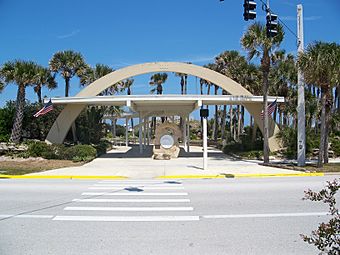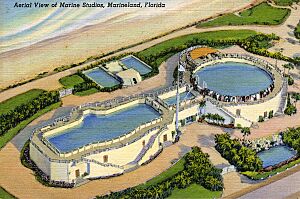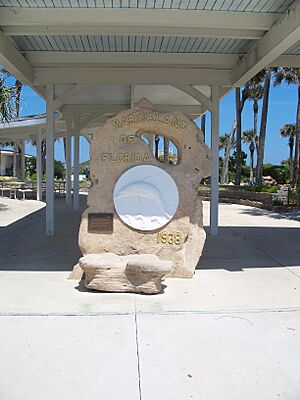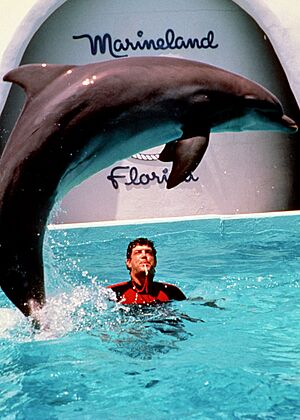Marineland of Florida facts for kids
Quick facts for kids |
|
|
Marine Studios
|
|
 |
|
| Location | Marineland, Florida |
|---|---|
| Built | 1937 |
| Architect | John Walter Wood and M.F. Hasbrouch |
| Architectural style | Moderne style |
| NRHP reference No. | 86000831 |
| Added to NRHP | April 14, 1986 |
Marineland of Florida, often called Marineland, was one of Florida's very first parks dedicated to marine animals. It was known as "the world's first oceanarium" – a giant aquarium designed to look like the ocean. Marineland is now a place where you can learn about and even swim with dolphins. It reopened to the public on March 4, 2006, and was bought by the Georgia Aquarium in 2011. In 2019, the park was sold to the Dolphin Discovery Group, which runs it today.
Contents
Marineland's Story
How Marineland Began
Marineland was first imagined by a group of people, including W. Douglas Burden and Cornelius Vanderbilt Whitney. They wanted to create a huge oceanarium where they could film marine life up close. They chose a spot on the Atlantic Ocean south of St. Augustine, which later became the town of Marineland.
Building Marineland was a big challenge because no one had ever tried to capture and keep sea creatures in such a large way before. But they succeeded! On June 23, 1938, "Marine Studios" (its first name) opened. Its main attraction was a bottlenose dolphin. More than 20,000 tourists showed up on opening day, eager to see the new park.
For many years, Marineland had not only its oceanariums but also a motel, restaurants, snack bars, a marina, and gift shops. The entire property was about 125 acres, located between the Atlantic Ocean and the Intracoastal Waterway.
The Oceanariums
The heart of "Marine Studios" was its two huge tanks, called oceanariums.
- The circular oceanarium was nicknamed the "circ tank." It was home to dolphins, and sometimes groupers and pelicans. This tank held 400,000 gallons of water and was 12 feet deep and 80 feet across.
- The rectangular oceanarium was called the "rec tank." It held 450,000 gallons of water and was home to many different fish, sharks, eels, and turtles. This tank was 100 feet long and 40 feet wide. It was even heated in winter to protect tropical fish!
These two oceanariums were connected by a shallow waterway called "the flume." Visitors could walk around the tanks on the top deck or go downstairs to view the marine life through many portholes. The original main entrance had an arch over a large slab of coquina rock that said "Marine Studios 1938."
Growing and Changing
In 1952, Marineland added a "porpoise stadium" with bleachers for shows. This is where "Flippy" the educated porpoise performed. Back then, dolphins were often called porpoises. A roof was added to the stadium in 1961. Around this time, the park started using the name "Marineland" more often in its advertising. In 1968, large arches spelling out MARINELAND were installed, making the park visible from far away.
Marineland kept growing through the 1950s and 60s. They built new administration buildings, a laboratory, and maintenance shops. On the ocean side, they added a large gift shop and a freshwater exhibit. This freshwater area later became a "shark nursery" and then "The Wonders of the Spring," showing fish from Florida's springs. A penguin display and a sea lion show were also added.
The park got its saltwater from pipes that went 50 feet out into the ocean. Pumps brought the water to a filtration plant, and then it circulated through the tanks. Marineland scientists even discovered that copper sulfate could help reduce algae growth in the tanks.
A Popular Spot
Marineland became a very popular place to visit. Famous writers like Marjorie Kinnan Rawlings and Ernest Hemingway even visited. The park was also used to film movies, including Creature from the Black Lagoon (1954) and Revenge of the Creature (1955).
The world's first dolphin trainer, Adolph Frohn, started developing "dolphin shows" in the early 1950s. These shows became a huge draw, and Marineland became one of Florida's main attractions, bringing in over 900,000 visitors a year by the mid-1970s. More attractions were added, like the Playport playground, a Shell Museum, and the Aquarius 3D Theater. A statue of King Neptune with dolphins was a centerpiece in one of the ponds.
Amazing Shows
Divers wearing special helmets would feed fish, eels, turtles, and dolphins by hand. "Jumpmasters" and trainers put on dolphin shows six times a day. Announcers would use bells and nautical time to let visitors know when the next show was starting.
Each show began with "jumping porpoises" on the top deck of the circular oceanarium. A "jumpmaster" would use a special movable arm, called a Skyworker, to make dolphins leap up to 16 feet out of the water! This was a Marineland invention. Then, the show moved downstairs, where visitors could watch a diver feed marine animals through the portholes. The diver would even go into the rectangular tank with sharks and moray eels! Finally, the crowd would go to the stadium to see the "educated porpoises" show, where dolphins showed off their skills.
Marineland staff wore nautical uniforms, with jumpmasters dressed like sailors and announcers like sea captains. Many other employees, like aquarists, guides, and pump crews, kept the park running smoothly. At one point, Marineland was the biggest employer in Flagler County, with over 300 employees.
Marineland also had its own unique freshwater system. It used a reverse osmosis plant to turn saltwater into freshwater for the entire park.
Challenges and Changes
When Walt Disney World opened in 1971 and SeaWorld Orlando opened in 1973, Marineland's popularity began to drop. In 1983, Cornelius Vanderbilt Whitney sold the park to a group of businessmen. They tried new ideas, like adding a high dive show and a sea lion show. The show schedule was also changed to make it easier for visitors. For a few years, Marineland even held Fourth of July fireworks events on the beach.
A large campground was built on the property, but big changes were coming. In late 1987, the park decided to modernize. Old diving helmets were replaced with modern SCUBA gear, and the nautical uniforms were changed. These changes, along with some poor management decisions, led to a decline in visitors. The park faced financial problems and was put up for sale again.
In the 1990s, Marineland faced more challenges, including new government rules and damage from hurricanes between 1999 and 2004. The park fell into disrepair, and many long-time employees were laid off. Parts of the park became unsafe. Eventually, a large part of Marineland's dolphin population was sold to SeaWorld in Orlando, and new owners took over.
A New Beginning
Hurricane Floyd and Irene in 1999 forced the park to close for two months due to extensive damage. In 2003, many of the park buildings were torn down, leaving only the original structures near the ocean. After being hit by three more hurricanes in 2004, the park closed completely for major renovations.
It reopened in 2006 as the Dolphin Conservation Center. The old oceanariums and stadium were beyond repair and were demolished. New, larger tanks were built, becoming the centerpiece of the new Marineland. This new facility has modern buildings, a pumping station, and a small museum with items from the old Marineland. The area where the original oceanariums stood became a parking lot. The old main entrance, walkway, and gift shop were saved.
The era of the original dolphin shows ended. Marineland was transformed into a hands-on educational center called the Marineland Dolphin Adventure. Guests can now interact directly with dolphins and see other marine life.
Next to Marineland, the University of Florida opened the Whitney Marine Laboratory in 1974, thanks to a gift from Cornelius Vanderbilt Whitney. This lab studies marine animals and is separate from Marineland's own research. Marineland's staff also helped with hundreds of stranded whale emergencies along the coast.
On January 1, 2011, the Georgia Aquarium bought Marineland. In 2019, the park was sold again to the Dolphin Discovery Group, which operates it today as "Marineland Dolphin Adventure."
Dolphins at Marineland
Marineland has been a place where dolphins are born and cared for. Three bottlenose dolphins, Tomo, Aqe, and Tocoi, were born at the new Dolphin Conservation Center in July 2008. Two male dolphins born in 2015 also lived at Marineland.
See also
 In Spanish: Marineland para niños
In Spanish: Marineland para niños






